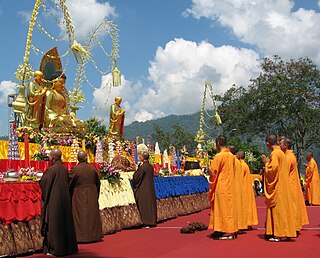
Vesak, also known as Buddha Jayanti, Buddha Purnima, Buddha Day, is a holiday traditionally observed by Buddhists in South Asia and Southeast Asia, as well as Tibet and Mongolia. It is the most important Buddhist festival. The festival commemorates the birth, enlightenment (Nibbāna), and passing (Parinirvāna) of Gautama Buddha in Theravada, Tibetan Buddhism and Navayana.
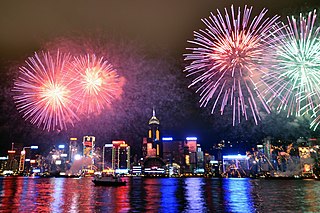
Lunar New Year is the beginning of a new year based on lunar calendars or, informally but more widely, lunisolar calendars. Lunar calendars follow the lunar phase while lunisolar calendars follow both the lunar phase and the time of the solar year. The event is celebrated by numerous cultures in various ways at diverse dates.

Tashi Paljor, Dilgo Khyentse Rinpoche was a Vajrayana master, scholar, poet, teacher, and recognized by Buddhists as one of the greatest realized masters. Head of the Nyingma school of Tibetan Buddhism from 1988 to 1991, he is also considered an eminent proponent of the Rime tradition.
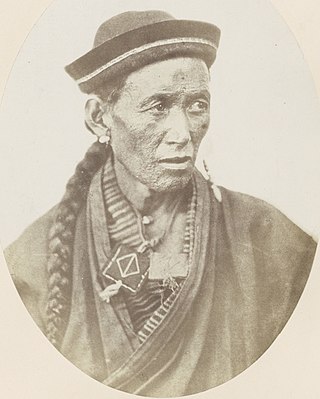
The Bhutia are a community of Sikkimese people living in the state of Sikkim in northeastern India, who speak Drenjongke or Sikkimese, a Tibetic language fairly mutually intelligible with standard Tibetan. In 2001, the Bhutia numbered around 60,300. Bhutia here refers to people of Tibetic ancestry.

Buddha's Birthday or "'Buddha Day"' is a primarily Buddhist festival that is celebrated in most of South, Southeast and East Asia, commemorating the birth of the prince Siddhartha Gautama, who became the Gautama Buddha and founded Buddhism. According to Buddhist tradition and archaeologists, Gautama Buddha, c. 563-483 BCE, was born at Lumbini in Nepal. Buddha's mother was Queen Maya Devi, who delivered the Buddha while undertaking a journey to her native home, and his father was King Śuddhodana. The Mayadevi Temple, its gardens, and an Ashoka Pillar dating from 249 BCE mark the Buddha's birth place at Lumbini.

Tibet developed a distinct culture due to its geographic and climatic conditions. While influenced by neighboring cultures from China, India, and Nepal, the Himalayan region's remoteness and inaccessibility have preserved distinct local influences, and stimulated the development of its distinct culture.

Kyabje Dudjom Jigdral Yeshe Dorje was known as Terchen Drodül Lingpa and as Dudjom Rinpoche. He is considered by many Tibetan Buddhists to be from a line of important Tulku lineage, and a renowned Tertön. Per lineage, he was a direct incarnation of both Padmasambhava and Dudjom Lingpa (1835–1904). He was a Nyingma householder, yogi, and a Vajrayana and Dzogchen master. According to his disciple Khenpo Tsewang Dongyal, he was revered as "His Holiness" and as a "Master of Masters".
Shabdrung Lama Kunga Thartse Rinpoche is a Tibetan teacher of the Sakya school of Vajrayana Tibetan Buddhism. Lama Kunga Rinpoche is licensed in California to perform marriages with a Tibetan Buddhist ceremony.
This is a list of topics related to Tibet.
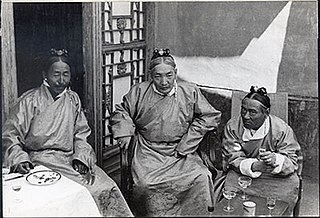
Trimön Shap-pe born Norbu Wangyal (1874–1945) was a highly prominent Tibetan aristocrat, conservative politician and governor, a former Finance Minister, and Chief Cabinet Minister of Tibet.. Trimon accompanied Regent Reting who jointly spearheaded the search to lake Lhamo Latso, leading to the discovery of Tenzin Gyatso, the 14th Dalai Lama in 1935. Trimon is regarded as an eminent personality and significant political figure in modern Tibetan history.
Thekchen Choling is a registered Buddhist organisation in the Republic of Singapore. The organisation was started in 2001 by Singha Thekchen Rinpoche and a group of his initial disciples. The organisation promotes non-sectarian Buddhism, emphasizing understanding of Theravada and Mahayana teachings. TCCL is committed to the Rime (non-sectarian) movement within Tibetan Buddhism though it is of the Gelug tradition. The primary practices and teachings of this temple are from Guru Rinpoche lineage and Lama Tsongkapa lineage.

The Khamba or Khemba, are a people who inhabit the Yang-Sang-Chu valley in the westernmost part of Arunachal Pradesh, near the borders with Tibet and Bhutan. Within the valley, they live in the villages Yorton, Lango, Tashigong, Nyukong and Mangkota.

Tashi delek is a Tibetan expression used to greet, congratulate or wish someone good luck. It is also used in Bhutan and Northeast India in the same way. "Tashi delek" is associated with Losar, the Tibetan festival celebrating the lunisolar new year.
Public holidays in Bhutan consist of both national holidays and local festivals or tshechus. While national holidays are observed throughout Bhutan, tsechus are only observed in their areas. Bhutan uses its own calendar, a variant of the lunisolar Tibetan calendar. Because it is a lunisolar calendar, dates of some national holidays and most tshechus change from year to year. For example, the new year, Losar, generally falls between February and March.

Galdan Namchot is a festival celebrated in Tibet, Nepal, Mongolia and many regions of Himalaya, particularly in Ladakh, India. It is to commemorate the birth as well as parinirvana (death) and the Buddhahood of Je Tsongkhapa, a famous Scholar/teacher of Tibetan Buddhism whose activities led to the formation of the Gelug school of Tibetan Buddhism. Galdan Namchot also marks the beginning of the new year celebrations in Ladakh.
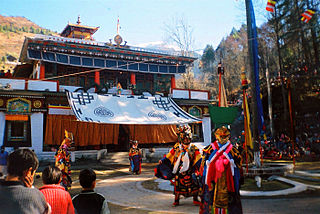
Losoong marks the end of harvest season, of the Bhutia tribe, celebrated every year in December.

Dosmoche is a Buddhist festival celebrated in Ladakh, India. It is celebrated in Leh, Likir and Diskit monasteries. It is the last festival of New Year Celebrations, the other one is Losar. The two-day Dosmoche festival is a gazetted holiday for Leh district and Zanskar Sub Division. Dosmoche is also known as the "Festival of Scapegoat" and is one of Ladakh's most popular prayer festivals. This festival is also celebrated to purify the town from evil spirits.

Mani Rimdu is a 19-day festival celebrated by Buddhists in the Everest region of Nepal to mark the founding of Buddhism by Guru Rinpoche Padmasambhava.

















